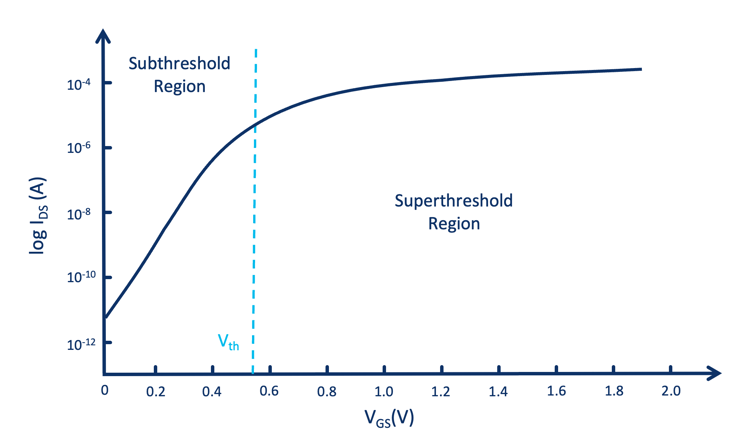Subthreshold IC Design
A powerful way to redefine low power!
Subthreshold IC design - A powerful way to redefine low power!
In recent years, the market for battery-powered devices has dramatically increased, boosting the number of batteries that must be replaced at one time or another. Along with the associated costs, this also has a strong impact on the planet’s sustainability!
Subthreshold IC design which operates transistors at voltage levels below their threshold voltage (Vth), presents an effective approach for enhancing the efficiency of low-power and low-frequency electronic devices. By doing so, battery life is extended, costs are reduced, and the overall appeal of the system is enhanced.
Fundamentals of subthreshold operation
The subthreshold or weak inversion region, as depicted in Fig. 1, occurs when the gate-to-source voltage (VGS) of a MOSFET is below its threshold voltage (Vth), resulting in a small amount of current between drain and source (IDS). Therefore, compared to its operation in the superthreshold region, the time required to charge or discharge internal nodes is greater, which limits the operating frequency.
Since dynamic consumption is increasing approximately with the square of the voltage supply (VDD), the reduction of this supply offers a strong advantage in designing competitive circuits and systems.

Figure 1: Subthreshold and Superthreshold regions of a n-type MOSFET transistor.
Challenges of subthreshold design
Subthreshold design faces different challenges that require innovative design techniques and robust testing to achieve good results. Some of them are related with:
-
PVT sensitivity
As shown in Fig. 1, IDS presents an exponential behaviour, i.e., a very small change in VGS, as a result of process, voltage, or temperature variation, will produce a strong IDS variation. Consequently, subthreshold circuits are more sensitive
to these variations, and thus require careful design and precise control. -
Noise margin
Since VDD is reduced in subthreshold designs, the signal swing decreases. Therefore, the circuit is more sensitive to external noise.
-
Device modelling
The near-threshold and subthreshold region typically do not have as accurate models as in the superthreshold, resulting in some uncertainty when devices are simulated in this region. Trying to overcome this, different models have been
proposed such as the EKV model - a dedicated model to the design of low-voltage mixed analog-digital circuits. -
Circuits/Architectures for subthreshold
Given the huge number of publications using superthreshold versus subthreshold, a fair comparison of subthreshold circuits in terms of immunity, performance, and power is difficult. Moreover, conventional digital circuits and architectures are typically implemented through the use of devices operating in the superthreshold region, where the states of transistors are distinctly defined as either 'on' or 'off'. When subthreshold designs are used, the challenges are completely different and other approaches are needed.
Download article
Subthreshold IC Design - A powerful way to redefine low power!
Subthreshold design in modern electronics
Subthreshold design in modern electronics is increasingly significant, mainly driven by the need for energy efficiency in a wide range of applications such as:
-
Micro-sensor networks and medical devices:
These applications typically prioritise energy efficiency above speed, with the ultimate goal of reducing the number of battery replacements. Subthreshold design enables the creation of devices that consume minimal power, with high reliability and long-lasting operation.
-
IoT devices
In the realm of the Internet of Things (IoT), devices often must operate subthreshold design in modern Electronics within strict power budgets or rely on harvested energy sources. By operating in the near-threshold or subthreshold region, IoT systems significantly reduce static and dynamic power consumption. This is particularly crucial for applications in remote or hard-to-access locations where battery replacement is challenging.
-
Wearable technology
Encompassing a broad range of products like smartwatches, fitness trackers, and medical monitoring devices, these devices are used continuously and are often expected to run for extended periods on limited battery resources. The implementation of subthreshold design in wearables ensures that these devices can function longer without the need for frequent recharging, thus enhancing user convenience and device usability.
Conclusion
The field of subthreshold IC design represents a significant advancement in the realm of energy-efficient electronics. Operating at voltages below the traditional threshold, subthreshold brings forth remarkable power savings, particularly in battery-powered and
portable devices.
Despite its inherent challenges, such as increased sensitivity to process variations and susceptibility to noise, the adoption of subthreshold continues to grow, driven by its substantial benefits in reducing power consumption and extending battery life. The advancements in design methodologies coupled with innovations in material science continue to mitigate these challenges, making subthreshold design an increasingly viable option for a wide range of applications.
The continued development and application of subthreshold design are set to play a crucial role in the future of electronics, particularly in the realms of IoT and wearable technology. This approach not only aligns with the growing demand for energy efficiency but also contributes to the broader goal of environmental sustainability in technology. Nanopower Semiconductor's contributions to subthreshold design underscore its potential to revolutionize power efficiency in modern electronics, making it a cornerstone in the development of the next generation of low-power, high-efficiency systems.